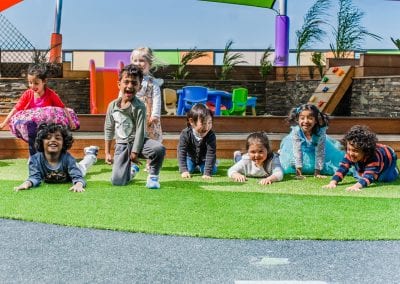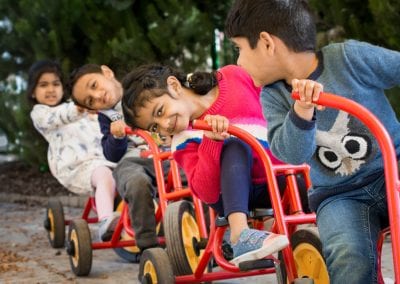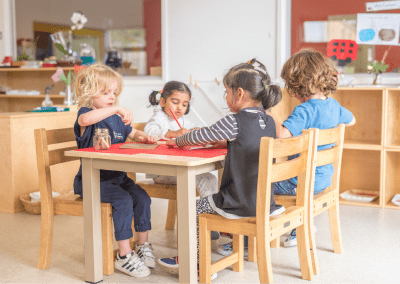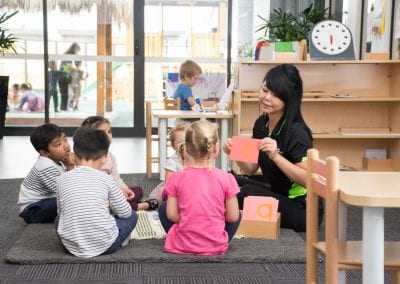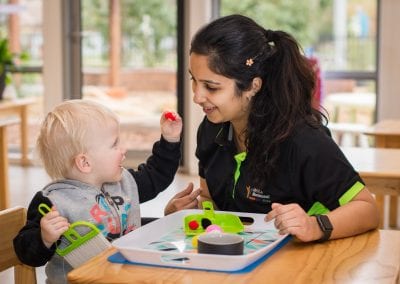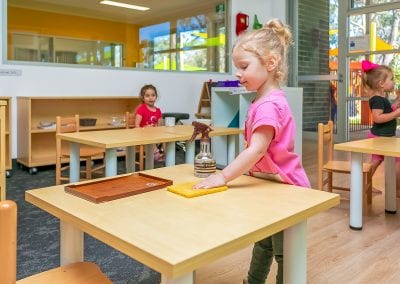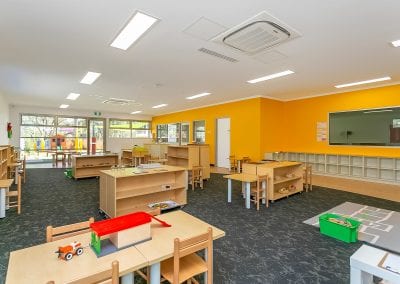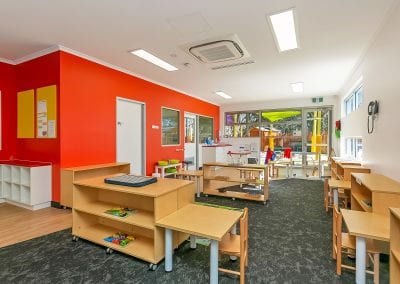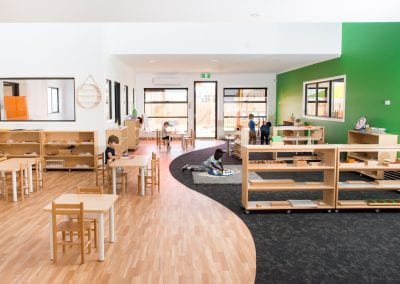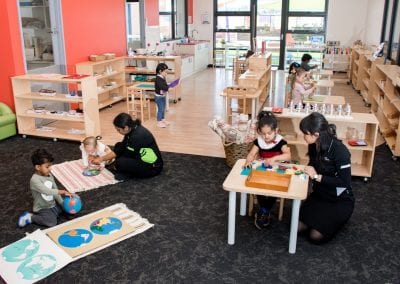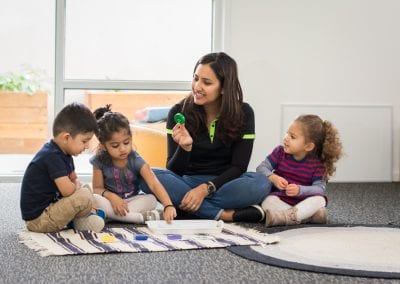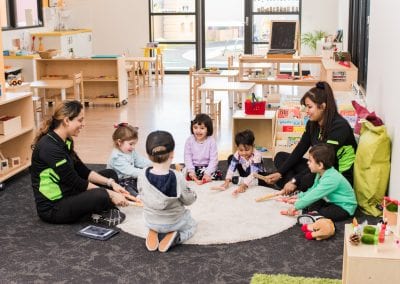Montessori Philosophy
AMIGA Montessori Philosophy
What is Montessori
Montessori is a method of teaching developed by Dr Maria Montessori in 1907. Her educational methods are based on scientific observations of children’s natural learning tendencies and willingness to learn as they unfold in prepared environments. Guided by her discovery that children teach themselves, Dr. Montessori designed the “prepared environment” in which children could freely choose from a number of developmentally appropriate activities.
The Montessori Environment contains specially designed, Manipulative Materials for development that invites children to engage in learning activities of their own individual choice. Under the guidance of a qualified teacher, children in a Montessori classroom learn by making discoveries with the materials, hereby promoting concentration, motivation, self-discipline, independence and a love of learning. The role of the Montessori Teacher can be described as ‘indirect teaching’ to be a quiet observer, to guide the child without letting them feel their presence or become an obstacle between them and their work. The Montessori Teacher is always ready only to supply assistance if and when desired by the child and in doing so assisting the child to do it themselves.
A Prepared Montessori Environment
Each classroom is divided into 5 main areas: Practical Life, Sensorial, Language, Mathematics and Cultural Enrichment, which is designed to facilitate maximum independent learning and exploration by the child. In the prepared environment, there is a variety of activity as well as a great deal of movement. In the calm, ordered space of the Montessori classroom, children work on activities of their own choice at their own pace. They experience a blend of freedom and self-discipline in a place especially designed to meet their own individual natural developmental needs.
Practical Life
Practical life materials and exercises respond to the young child’s natural interests to develop physical coordination (pouring, scooping and sorting activities, as well as washing a table and food preparation to develop hand-eye coordination), care of self (personal hygiene, dressing activities, grace and courtesy) and care of the environment (looking after the classroom, looking after the garden.
Sensorial
The sensorial materials provide a range of activities and exercises for children to experience the natural order of the physical environment, including such attributes as size, colour, shape and dimension. Examples of these materials are pink tower (series of ten sequential cubes, varying in volume); knobbed cylinders (wooden blocks with 10 depressions to fit variable sized cylinders); broad stairs (ten wooden blocks, sequentially varying in two dimensions); colour tablets (coloured objects for matching pairs or grading shapes of color).
Mathematics
In this area, materials are provided to show such basic concepts as numeration, place value, addition, subtraction, division and multiplication. For numeration, there is a set of ten rods, with segments colored red and blue and “spindle boxes”, which consist of placing sets of objects in groups, 1–10, into separate compartments. For learning the numeral symbols, there is a set of sandpaper numerals, 1–9. For learning addition, subtraction, and place value, materials provide decimal representation of 1, 10, 100, etc., in various shapes made of beads, plastic, or wood. Beyond the basic math materials, there are materials to show the concept of fraction, geometrical relationships and algebra, such as the binomial and trinomial theorems.
Language
Montessori language materials provide experiences to develop use of a writing instrument and the basic skills of reading a written language. For writing skill development, the metal insets provide essential exercises to guide the child’s hand in following different outline shapes while using a pencil. For reading, a set of individual letters, commonly known as sandpaper letters, provide the basic means for associating the individual letter symbols with their corresponding phonetic sounds. When the child is proficient with the majority of the sounds, he can create words using moveable letters from the “moveable alphabet”. When their hand is strong enough from use with the Metal Insets and other materials, he may write words with a pencil using the shapes he learned from the sandpaper letters. Following writing with the movable alphabet, the child begins to read words. Montessori language materials have also been developed to help children learn grammar, including parts of speech such as nouns, verbs, adjectives, articles, prepositions, adverbs, conjunctions, pronouns, and interjections.
Cultural subjects
The Montessori classroom may also include other materials and resources to learn cultural subjects, such as geography (map puzzles, globes, cultural suitcases containing country-specific materials), and science, such as biology in naming and organizing plants and animals. Music and art are also commonly involved with children in various ways.
What are Materials for Development
The items found on the shelves in the classroom are referred to “materials” rather than “toys.” The children “work with the materials” rather than “play with the toys.” This allows the children to gain the most benefit from the environment by giving them a sense of worth. In the Montessori classroom, learning materials are arranged invitingly on low, open shelves. Children may choose whatever materials they would like to use and may work for as long as the material holds their interest. When they are finished with each material, they return it to the shelf from which it came. The materials are also self-correcting. When a piece does not fit or is left over, the child easily perceives the error. There is no need for adult “correction”, thus the child is able to solve problems independently, building self-confidence, analytical thinking, and the satisfaction that comes from accomplishment.
About Dr Maria Montessori
Maria Montessori was always a little ahead of her time. She was born in Italy in 1870, and in 1896, became the first female doctor in Italy. Dr. Montessori based her work on the direct observation of children. She accepted no preconceived opinions or theories about their abilities, nor did she attempt to manipulate their behaviour by reward or punishments toward any end. She constantly experimented and developed materials based on the interests, needs, and developing abilities of children.
Like others I had believed that it was necessary to encourage a child by means of some exterior reward that would flatter his baser sentiments, such as gluttony, vanity, or self-love, in order to foster in him a spirit of work and peace. And I was astonished when I learned that a child who is permitted to educate himself really gives up these lower instincts. I then urged the teachers to cease handing out the ordinary prizes and punishments, which were no longer suited to our children and to confine themselves to directing them gently in their work.
– Dr. Montessori
In her work at the University of Rome’s psychiatric clinic, Dr. Montessori developed an interest in the treatment of children and for several years wrote and spoke on their behalf. At age twenty-eight, she became the director of a school for mentally-disabled children. After two years under her guidance, these children, who formerly had been considered uneducable, took a school examination along with normal children and passed successfully. Educators called Dr. Montessori a miracle worker. What was her response? If mentally disabled children could be brought to the level of normal children, Dr. Montessori wanted to study the potential of “normal” children. She went back to school to study anthropology and psychology and finally, in 1907, was asked to take charge of fifty children from the dirty, desolate streets of the San Lorenzo slum in the city of Rome.
When the children had completed an absorbing bit of work, they appeared rested and deeply pleased. It almost seemed as if a road had opened up within their souls that led to all their latent powers, revealing the better part of themselves. They exhibited a great affability to everyone, put themselves out to help others and seemed full of good will.”
– Dr. Montessori
invited to the USA by Alexander Graham Bell, Thomas Edison, and others, Dr. Montessori made an appearance at Carnegie Hall in New York by 1915.
The following is a letter from this period, from Alexander Graham Bell:
“Dear Dr. Montessori, On behalf of the Montessori Educational Association of America I have the honour to inform you that we have elected you as its first honorary member and to express to you in this way our deep appreciation of your great work for humanity”
Dr. Montessori was then invited to set up a classroom at the Panama-Pacific International Exposition in San Francisco so that more interested people could observe her methods. A room was built with a glass wall behind which spectators sat and watched the children. Twenty-one children, all completely new to a Montessori environment, attended for four months. The observation seats were filled every day and at noon, when the children served lunch to their classmates and washed up afterwards, there was standing room only in the audience. The two gold medals awarded for education at the Panama-Pacific International Exposition both went to the Montessori class.
After W.W.II Dr. Montessori’s concern with education for peace intensified and she was twice nominated for the Nobel Peace Prize. She instituted the study of Cosmic Education for the child from six to twelve years of age, since she could see that in meeting the needs of the child, the needs of the world would also be met. “Cosmic Education” is the child’s gradual discovery, throughout the whole of childhood, of the interrelatedness of all things on earth, in the past, in the present, and in the future.

